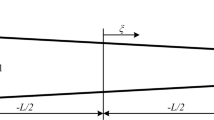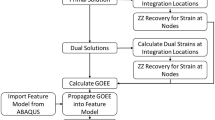Abstract
This paper discusses the use of higher-order mapping functions for enhancing the physical representation of refined beam theories. Based on the Carrera unified formulation (CUF), advanced one-dimensional models are formulated by expressing the displacement field as a generic expansion of the generalized unknowns. According to CUF, a novel physically/geometrically consistent model is devised by employing Legendre-like polynomial sets to approximate the generalized unknowns at the cross-sectional level, whereas a local mapping technique based on the blending functions method is used to describe the exact physical boundaries of the cross-section domain. Classical and innovative finite element methods, including hierarchical p-elements and locking-free integration schemes, are utilized to solve the governing equations of the unified beam theory. Several numerical applications accounting for small displacements/rotations and strains are discussed, including beam structures with cross-sectional curved edges, cylindrical shells, and thin-walled aeronautical wing structures with reinforcements. The results from the proposed methodology are widely assessed by comparisons with solutions from the literature and commercial finite element software tools. The attention is focussed on the high computational efficiency and the marked capabilities of the present beam model, which can deal with a broad spectrum of structural problems with unveiled accuracy in terms of geometrical representation of the domain boundaries.



















Similar content being viewed by others
References
Euler L (1744) De curvis elasticis. Bousquet, Lausanne
Timoshenko SP (1922) On the transverse vibrations of bars of uniform cross section. Phil Mag 43:125–131
Kapania RK, Raciti S (1989) Recent advances in analysis of laminated beams and plates, part I: shear effects and buckling. AIAA J 27(7):923–935
Kapania RK, Raciti S (1989) Recent advances in analysis of laminated beams and plates, part II: vibrations and wave propagation. AIAA J 27(7):935–946
Carrera E, Pagani A, Petrolo M, Zappino E (2015) Recent developments on refined theories for beams with applications. Mech Eng Rev 2(2):1–30
Reddy JN (1997) On locking-free shear deformable beam finite elements. Comput Methods Appl Mech Eng 149:113–132
Vinayak RU, Prathap G, Naganarayana BP (1996) Beam elements based on a higher order theory—I. Formulation and analysis of performance. Comput Struct 58(4):775–789
Gruttmann F, Sauer R, Wagner W (1999) Shear stresses in prismatic beams with arbitrary cross-sections. Int J Numer Methods Eng 45:865–889
Wagner W, Gruttmann F (2002) A displacement method for the analysis of flexural shear stresses in thin-walled isotropic composite beams. Comput Struct 80:1843–1851
Petrolito J (1995) Siffness analysis of beams using a higher-order theory. Comput Struct 55(1):33–39
Schardt R (1989) Verallgemeinerte technische biegetheorie. Springer, Berlin
Davies JM, Leach P (1994) First-order generalised beam theory. J Constr Steel Res 31(2):187–220
Davies JM, Leach P, Heinz D (1994) Second-order generalised beam theory. J Constr Steel Res 31(2):221–241
Silvestre N, Camotim D (2002) First-order generalised beam theory for arbitrary orthotropic materials. Thin-Walled Struct 40(9):755–789
Silvestre N, Camotim D (2002) Second-order generalised beam theory for arbitrary orthotropic materials. Thin-Walled Struct 40(9):791–820
Silvestre N (2007) Generalised beam theory to analyse the buckling behaviour of circular cylindrical shells and tubes. Thin-Walled Struct 45:185–198
Simo JC, Vu-Quoc L (1991) A geometrically-exact rod model incorporating shear and torsion-warping deformation. Int J Solids Struct 27(3):371–393
Pimienta PM, Campello EMB (2003) A fully nonlinear multi-parameter rod model incorporating general cross-section in-plane changes and out-of-plane warping. Latin Am J Solids Struct 1(1):119–140
Gonçalves R, Ritto-Corra M, Camotim D (2010) A large displacement and finite rotation thin-walled beam formulation including cross-section deformation. Comput Methods Appl Mech Eng 199(2324):1627–1643
Campello EMB, Lago LB (2014) Effect of higher order constitutive terms on the elastic buckling of thin-walled rods. Thin-Walled Struct 77:8–16
Carrera E (2002) Theories and finite elements for multilayered, anisotropic, composite plates and shells. Arch Comput Methods Eng 9(2):87–140
Carrera E (2003) Theories and finite elements for multilayered plates and shells: a unified compact formulation with numerical assessment and benchmarking. Arch Comput Methods Eng 10(3):216–296
Carrera E, Giunta G (2010) Refined beam theories based on Carrera’s unified formulation. Int J Appl Mech 2(1):117–143
Szabó B, Babuka I (1991) Finite element analysis. Wiley, London
Gordon WJ, Hall CA (1973) Transfinite element methods: blending-function interpolation over arbitrary curved element domains. Numer Math 21(2):109–129
Düster A, Bröker H, Rank E (2001) The p-version of the finite element method for three-dimensional curved thin walled structures. Int J Numer Methods Eng 52(7):673–703
Királyfalvi G, Szabó B (1997) Quasi-regional mapping for the p-version of the finite element method. Finite Elem Anal Des 27(1):85–97 (Robert J. Melosh Medal Competition)
Hughes TJR, Cottrell JA, Bazilevs Y (2005) Isogeometric analysis: CAD, finite elements, NURBS, exact geometry and mesh refinement. Comput Methods Appl Mech Eng 194(3941):4135–4195
Washizu K (1968) Variational methods in elasticity and plasticity. Pergamon, Oxford
Petrolo M, Carrera E, Giunta G (2011) Beam structures: classical and advanced theories. Wiley, London
Carrera E, Petrolo M, Zappino E (2012) Performance of CUF approach to analyze the structural behavior of slender bodies. J Struct Eng 138(2):285–297
Carrera E, Pagani A, Petrolo M (2013) Use of Lagrange multipliers to combine 1D variable kinematic finite elements. Comput Struct 129:194–206
Carrera E, Pagani A (2013) Analysis of reinforced and thin-walled structures by multi-line refined 1D/beam models. Int J Mech Sci 75:278–287
Carrera E, Pagani A (2015) Evaluation of the accuracy of classical beam FE models via locking-free hierarchically refined elements. Int J Mech Sci 100:169–179
Carrera E, Petrolo M (2012) Refined beam elements with only displacement variables and plate/shell capabilities. Meccanica 47(3):537–556
Carrera E, Maiarù M, Petrolo M (2012) Component-wise analysis of laminated anisotropic composites. Int J Solids Struct 49:1839–1851
Carrera E, Pagani A, Petrolo M (2013) Component-wise method applied to vibration of wing structures. J Appl Mech 80(4):041012
Carrera E, Pagani A, Petrolo M (2013) Classical, refined and component-wise theories for static analysis of reinforced-shell wing structures. AIAA J 51(5):1255–1268
Carrera E, Pagani A, Petrolo M (2014) Refined 1D finite elements for the analysis of secondary, primary, and complete civil engineering structures. J Struct Eng 141(4):art. no. 04014123
Carrera E, Pagani A (2014) Free vibration analysis of civil engineering structures by component-wise models. J Sound Vib 333(19):4597–4620
Carrera E, Pagani A, Jamshed R (2016) Refined beam finite elements for static and dynamic analysis of hull structures. Comput Struct 167(C):37–49
Carrera E, de Miguel AG, Pagani A (2016) Hierarchical theories of structures based on Legendre polynomial expansions with finite element applications. Int J Mech Sci. doi:10.1016/j.ijmecsci.2016.10.009
Szabó B, Dster A, Rank E (2004) The p-version of the finite element method. Wiley, London
Pagani A, de Miguel AG, Petrolo M, Carrera E (2016) Analysis of laminated beams via unified formulation and Legendre polynomial expansions. Compos Struct 156:78–92
Carrera E, Cinefra M, Zappino E, Petrolo M (2014) Finite element analysis of structures through unified formulation. Wiley, London
Vlasov VZ (1961) Thin-walled elastic beams. Israel Program for Scientific Translations, Jerusalem
Saint-Venant B (1855) Memoire sur la torsion des prismes. Mem Acad Sci Savants Etrangers 14:233–560
MSC Software Corporation (2010) MD Nastran 2010 quick reference guide
Carrera E, de Miguel AG, Pagani A (2017) Extension of MITC to higher-order beam models and shear locking analysis of compact, thin-walled and composite structures. Submitted
Belytschko T, Stolarski H, Liu WK, Carpenter N, Ong JS-J (1985) Stress projection for membrane and shear locking in shell finite elements. Comput Methods Appl Mech Eng 51:221258
Bathe K-J, Dvorkin E N (1986) A formulation of general shell elements the use of mixed interpolation of tensorial components. Int J Numer Methods Eng 22(3):697–722
Zienkiewicz OC, Taylor RL (1977) The finite element method, vol 3. McGraw-hill, London
Macneal RH, Harder RL (1985) A proposed standard set of problems to test finite element accuracy. Finite Elem Anal Des 1(1):3–20
Scordelis AC, Lo KS (1964) Computer analysis of cylindrical shells. J Am Concr Inst 61:561593
Chinosi C, Della Croce L, Scapolla T (1998) Hierarchic finite elements for thin Naghdi shell model. Int J Solids Struct 35(16):1863–1880
Cinefra M, Chinosi C, Della Croce L (2013) MITC9 shell elements based on refined theories for the analysis of isotropic cylindrical structures. Mech Adv Mater Struct 20(2):91–100
Carrera E, Pagani A, Petrolo M (2013) Classical, refined, and component-wise analysis of reinforced-shell wing structurescomponent-wise method applied to vibration of wing structures. AIAA J 51(5):1255–1268
Carrera E, Pagani A (2016) Accurate response of wing structures to free-vibration, load factors, and nonstructural masses. AIAA J 54(1):227–241
Acknowledgements
This research has been carried out within the project FULLCOMP—FULLy analysis, design, manufacturing, and health monitoring of COMPosite structures—funded by the Marie Sklodowska-Curie actions Grant Agreement No. 642121. The H2020 European Training Networks are gratefully acknowledged.
Author information
Authors and Affiliations
Corresponding author
Rights and permissions
About this article
Cite this article
Pagani, A., de Miguel, A.G. & Carrera, E. Cross-sectional mapping for refined beam elements with applications to shell-like structures. Comput Mech 59, 1031–1048 (2017). https://doi.org/10.1007/s00466-017-1390-7
Received:
Accepted:
Published:
Issue Date:
DOI: https://doi.org/10.1007/s00466-017-1390-7




